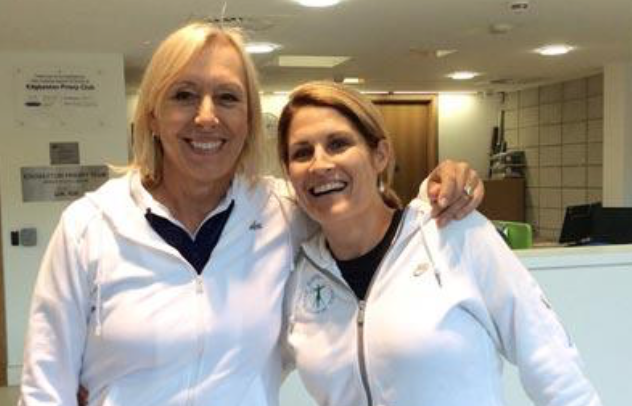People often ask me who my favorite player of all time. Hands down, Martina Navratilova!
I will never forget my first time meeting her. I was 16 years old and had received the wildcard for the tournament in Filderstadt (the one where the winner gets a Porsche). Prior to that, my biggest tournaments had been challengers. Now I was playing with the big girls, and I can clearly remember how intimidated I was seeing players in real life who I had only ever seen on TV. Regardless, I played well and qualified for the main draw. But then it hit—in my first ever main draw match on the WTA tour, I had to play then # 1 in the world, Martina Navratilova. On top of that, we were scheduled to play a night match in front of some 2,500 people. So here is a little 16 years old me, never having played a main draw match before, and 20 yards away in the waiting area to be escorted to the court is the best player in the world. I was shaking like a leaf and completely afraid to get on court. My heart was racing, and it felt like I had forgotten how to breathe.
This is when Martina did the most amazing thing. She came over, put her arm around my shoulder and said, “Hey, it’s gonna be ok. I watched you play, you’re gonna be just fine. Take a few deep breaths, keep hitting that backhand and we’ll go out and play some tennis.” Wait, what?!?!? The best player in the world had basically just coached me before I was to play her? What was is that she had told me? Breathe! And breathe I did! All the way to the court I focused on nothing but taking deep breaths. It still took me the entire warm-up and a good chunk of the first set to settle my nerves but I ended up playing two respectable sets.
What I learned from Martina that day was that you can manage the stress you experience with breathing. What Martina didn’t tell me was that you have to work on your breathing as part of an in-between point routine. And you have to work on it just like you practice your service motion or footwork patterns EVERY DAY. Therefore, working with my own breath was more of a learn-as-I-went experience rather than a very focused and intentional part of my game.
Now, as a mental skills coach, I use Martina’s golden nugget to help athletes anchor their individual routines around specific breathing patterns. Taking a few deep breaths creates a pause that allows the athlete to reframe negative statements into positive and actionable keywords. It shouldn’t be surprising that I’m a big fan of Mindful Awareness Training. Maybe Martina was ahead of the game in that respect as well and let the rest of the world figure out 30 years later how powerful Mindfulness is for athletes.
Next time you find yourself in a very stressful situation (either in sports or “real” life such as a job interview, difficult conversation with a loved one, public speaking events, etc.), take two deep breaths with the following pattern: take a breath in to the count of 4 and release to the count of 5. Do it again and count along in your head. Possibly you will note a lessening of physical tension or less need to start hollering and screaming. Maybe there is a little more room now to think of a better alternative to your usual habitual response.
Go ahead, give it a try!
ABOUT MEIKE
Meike is a former world-class tennis player and reached a career high of #27 in singles and #45 in doubles in 1995 on the WTA tour. In 1992, Meike was nominated as “WTA Rookie of the Year”.
She played in 19 Grand Slam Tournaments and represented her native country, Germany, in the Fed Cup competition. After retiring from the pro tour, Meike was the assistant coach for women’s tennis at Tulane University and Vanderbilt University.
In 2008, Meike graduated from Vanderbilt with a degree in Human and Organizational Development.
She received further training from Duke University Integrative Medicine to assist clients in behavior modification using various proven methods including mindfulness and motivational interviewing.

